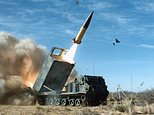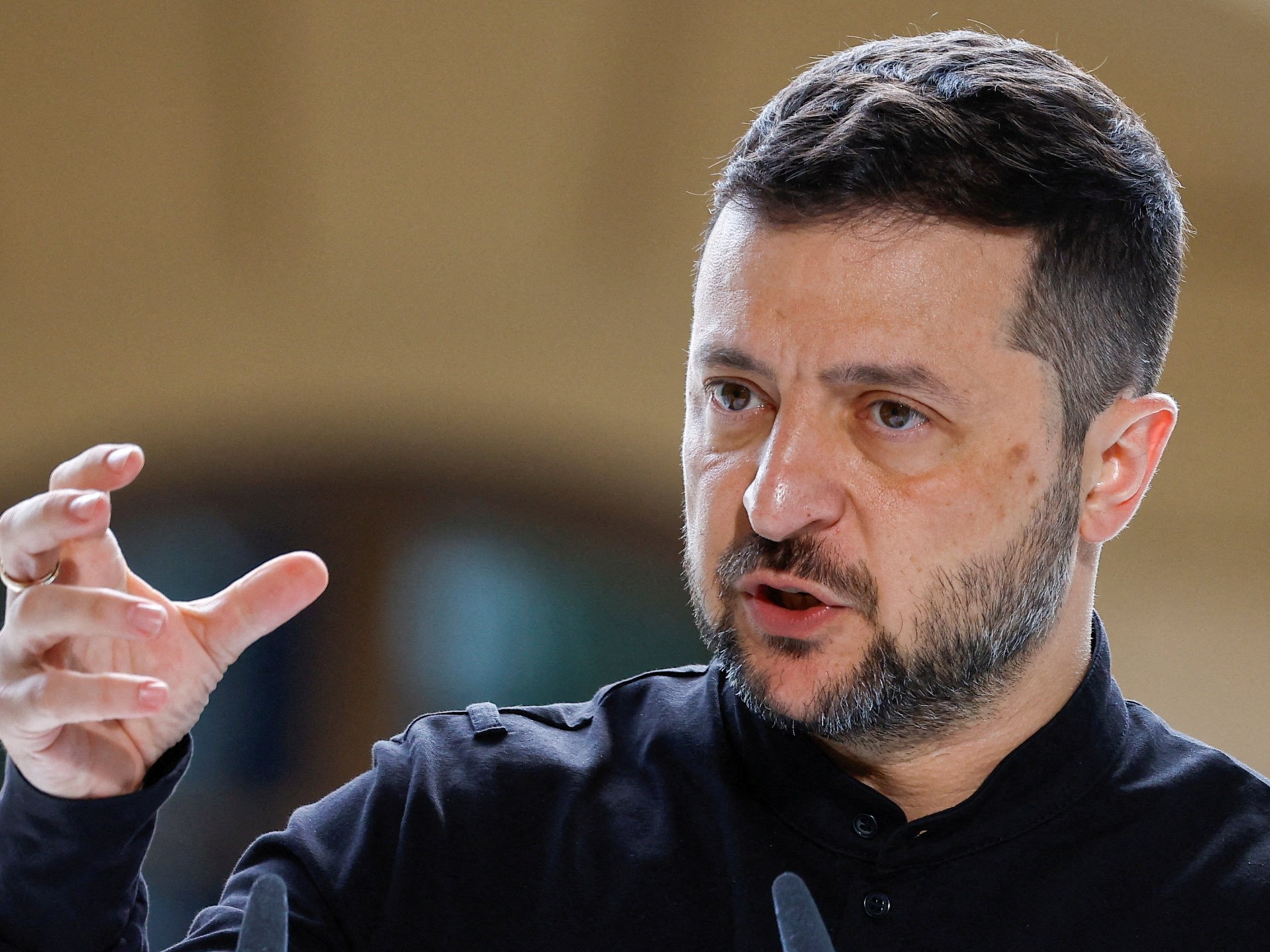
Ukraine has carried out its first strike on Russian territory with US-supplied long-range missiles just days after the Biden administration gave Kyiv the green light despite fears it could escalate the conflict beyond control.
A fiery explosion at an ammunition depot in Karachev around 75 miles from the Ukrainian border in Russia‘s Bryansk region lit up the night sky early this morning on what is the 1,000th day of war in Ukraine.
Eyewitnesses along with Russian and Ukrainian military bloggers first reported the attack, with anonymous Ukrainian military officials later telling RBC Ukraine the strike was conducted with the US-manufactured ATACMS (Army Tactical Missile System).
Kyiv is yet to officially confirm the ATACMS strike, but Russia’s Defence Ministry claimed they shot down five missiles. A sixth missile was damaged but ultimately landed on the military facility, it said.
The reports emerged within minutes of the Kremlin threatening a ‘nuclear response’ should Ukraine hit targets on Russian soil with Western-supplied long-range munitions.
‘The Russian Federation reserves the right to use nuclear weapons in the event of aggression against it with the use of conventional weapons,’ Kremlin press secretary Dmitry Peskov told reporters in Russia this morning.
His statement followed Vladimir Putin‘s approval of an updated nuclear doctrine that allows his strategic forces to deploy nuclear weapons if Russian or Belarusian territory is threatened by a non-nuclear nation supported by a nuclear power.
Threats that could make Russia’s leadership consider a nuclear strike include an attack with conventional missiles, drones or other aircraft, according to the updated document.
A Ukrainian strike on Russian territory with US-supplied missiles meets these criteria, raising fears that Moscow may now consider a dramatic escalation in the conflict.
But Ukraine’s foreign ministry issued a defiant statement in spite of the Kremlin’s nuclear sabre-rattling, declaring that ‘Ukraine will never submit to the occupiers and the Russian military will be punished for violating international law’.
‘We need peace through strength, not appeasement,’ the ministry added, as Volodymyr Zelensky called on Kyiv’s allies to ‘force’ Moscow into a ‘just peace’ and vowed his troops would ‘never surrender’.
A fiery explosion lit up the night sky around 77 miles from the nearest Ukrainian border at an ammunition store in Karachev, in Russia ‘s Bryansk region
ATACMS – Army Tactical Missile – being fired from an M270 Multiple Launch Rocket System
Zelensky called on Kyiv’s allies to ‘force’ the Kremlin into a ‘just peace’ and vowed his forces would ‘never surrender’ to Russia in a speech to Parliament this morning
Zelensky has long pressed his Western allies to allow his country to strike military targets deeper inside Russia, saying the restriction had made it impossible for Kyiv to try to stop Russian attacks on its cities and electrical grids.
But Kyiv’s Western backers had resisted his pleas amid fears that doing so would cross a ‘red line’ set by Putin – until this past weekend when the Biden administration sensationally lifted the blanket ban.
Putin, who today signed the decree formalising Russia’s updated nuclear doctrine, first announced changes to the document in September.
At the time, the Russian President said he would consider Western nations ‘direct participants’ in the war in Ukraine if they were to provide Kyiv with the ability to strike targets inside Russia.
He also suggested he may provide Russian missiles to Western adversaries to strike Western targets abroad as a course of retaliation.
Now, as fears grow over the potential fallout of Western missiles striking targets in Russia, Zelensky is insisting that 2025 will prove a ‘decisive year’ in determining who wins the war.
‘In the decisive moments – and they are coming next year – we must not allow anyone in the world to doubt the resilience of our entire state,’ the Ukrainian president told Parliament in a rousing address today.
‘At this stage, it is being decided who will prevail.’
Zelensky said last month he believed the war could be ended in 2025, provided that Western nations provide Ukraine with enough military and diplomatic support as part of his ‘peace plan’.
He repeated these comments last week, saying that the conflict would be ended sooner with Donald Trump in the White House.
NATO Secretary General Mark Rutte also backed Zelensky in comments to reporters in Brussels today as he joined EU ministers for defence talks on the 1,000th day of the war.
‘Why is this so crucial that Putin will not get his way? Because you will have an emboldened Russia on our border… and I’m absolutely convinced it will not stop there,’ Rutte said.
‘It is then posing a direct threat to all of us in the West,’ he said, adding he would ‘discuss how we can help Ukraine to prevail’.
‘We need simply to do more. We have to ramp up the defence industry,’ he said.
Rutte’s comments come as NATO holds its largest-ever artillery exercise just 70 miles from the border where the British Army is testing what military chiefs have described as a ‘game-changing’ weapon.
Finland, which joined the military alliance last year, is hosting up to 3,600 soldiers from 28 nations for the exercise, known as Dynamic Front.
Live fire drills began on Sunday in the northern Lapland region, and are part of a series of exercises, with further ones planned in Estonia, Germany, Romania and Poland.
The British Army is using the opportunity to put its Archer 155-mm guns to the test, weapons which can release high explosive shells or GPS-guided munitions and hit targets 30 miles away.
The guns have been labelled a battlefield game-changer by British troops, with Major Barney Ingram telling the i newspaper that ‘you can, realistically, with this capability, neutralise most targets’.
Snowflakes are illuminated during live firing of the British Army’s new Archer Mobile Howitzer gun near Rovaniemi in the Arctic Circle
British Army soldiers and armoured vehicles are taking part in the Arctic drills
Zelensky is insisting that 2025 will prove a ‘decisive year’ in determining who wins the war
NATO Secretary General Mark Rutte speaks to the members of press ahead of EU Defence Ministers’ meeting in Brussels, Belgium on November 19, 2024
Putin’s tightly controlled state TV has also made open threats of a nuclear attack on Britain and the US in the wake of the Biden administration’s decision to permit Ukraine to use long-distance missiles to target Russian territory.
The Kremlin chief’s propagandists expressed fury at Biden for giving Ukraine the green light to strike targets inside Russia with the coveted ATACMS system that has a range of up to 190 miles.
What is the Army Tactical Missile System (ATACMS)?
The US-made Army Tactical Missile System (ATACMS) uses solid propellant to fire explosive projectiles at ranges of up to 300km/190 miles (roughly the same distance from London to the outer suburbs of Paris).
There are four variants of the ATACMS, two of which – the M39 Block I and the M39A1 Block I – contain 950 and 300 M74 bomblets respectively.
Each of these bomblets is roughly the size of a baseball, and in the case of the M39, 950 are dispersed over an area of 677 feet in diameter – covering 360,000 square feet – making them highly effective at destroying groups of parked aircraft, ammunition dumps, aid defence systems – as well as gatherings of troops.
Moscow also sees it as highly likely that Britain and France will mirror the decision by granting Ukraine permission to use their Storm Shadow and SCALP missiles, though this is yet to be confirmed.
The Russians claim that a strike with Western weapons on Russian soil crosses a line laid down by Putin and directly implicates the West in the war, arguing that Ukraine cannot target these sophisticated missiles to strike Russia without US, British or French assistance.
Andrey Gurulev, reservist Russian army general, hardline MP, and pro-Putin TV propagandist, warned of a full-scale nuclear strike on Britain to show the dictator’s intent.
‘There are individual targets that can be hit with….demonstrative warning strikes,’ he said. ‘The first candidate to get a nuclear bludgeon….is the UK.’
Embarking on a rant on live television, Gurulev said the West was scared of Putin’s hypersonic nuclear arsenal.
‘I assure you that there will be no backlash [against Russia],’ he said.
‘Our arsenal in Russia, 100% deters either Biden or Trump from using nuclear weapons against Russia.’
He also declared that ‘if anyone has the urge to launch ATACMS, SCALP, Storm Shadow missiles… there will be essentially nothing left of America trying to pull us into escalation.
‘There will be no Biden and no Trump. The American people and we know this perfectly well.’
A Yars intercontinental ballistic missile is test-fired from the Plesetsk launchpad in northwestern Russia
Putin approved an updated nuclear doctrine that would allow his strategic missile forces to deploy nuclear weapons if Russia was subject to a conventional missile assault from a non-nuclear nation supported by a nuclear power
US Army Tactical Missile System (ATACMS) is seen in action
Rescuers work at the site of a residential building hit by a Russian drone strike, amid Russia’s attack on Ukraine, in the town of Hlukhiv, Sumy region, Ukraine, in this handout picture released November 19, 2024
Meanwhile, in a UN security council debate marking the 1,000th day of war in Ukraine, Putin’s permanent representative to the UN Vasily Nebenzya said the use of Western missiles in Russia amounted to ‘suicidal strikes’.
He also urged a rethink from Britain and France.
Russia’s updated nuclear doctrine
Putin has signed a revised nuclear doctrine declaring that a conventional attack on Russia by any nation that is supported by a nuclear power will be considered a joint attack on his country.
His endorsement of the new nuclear deterrent policy comes on November 19, 2024 – the 1,000th day after he sent troops into Ukraine on February 24 2022.
The signing of the new doctrine reflects Putin’s readiness to threaten use of the country’s nuclear arsenal to force the West to back down as Moscow presses a slow-moving offensive in Ukraine.
Putin first announced changes in the nuclear doctrine in September, when he chaired a meeting discussing the proposed revisions.
The new version of the document states that an attack against his country by a non-nuclear power with the ‘participation or support of a nuclear power’ will be seen as their ‘joint attack on the Russian Federation’.
It does not specify whether such an attack would necessarily trigger a nuclear response.
At the same time, it spells out conditions for using nuclear weapons in greater detail compared to the previous version of the doctrine, noting they could be used in case of a massive air attack involving ballistic and cruise missiles, aircraft, drones and other flying vehicles.
The wide formulation appears to significantly broaden the triggers for possible nuclear weapons-use compared with the previous version of the document, which stated that Russia could tap its atomic arsenal if ‘reliable information is received about the launch of ballistic missiles targeting the territory of Russia or its allies’.
‘Regardless of the militaristic fervour of the Democratic administration, which, having lost the presidential election with a bang… is giving suicidal permits to Zelensky’s regime to use long-range weapons to strike deep into Russian territory.
‘Perhaps Joe Biden himself, for many reasons, has nothing to lose,’ he said.
‘But the short-sightedness of the British and French leadership, which are rushing to play along with the outgoing administration and dragging not only their countries but the whole of Europe into a full-scale escalation with extremely serious consequences, is striking.
‘This is exactly what our former Western partners should think about before it is too late.’
Putin has long warned that Moscow would consider Ukraine’s Western allies directly party to the conflict if their weapons are used by Kyiv’s troops to strike targets on Russian soil, setting out a series of red lines that Western leaders have largely been reluctant to test.
In June, he issued a thinly veiled threat saying he would consider providing Western foes with Russian missiles to strike the West’s assets if the US or European nations went ahead with allowing Ukraine to hit Russia with ATACMS or Storm Shadow missiles.
‘If someone is thinking it is possible to supply such weapons to a war zone to strike our territory and create problems for us, why can’t we supply our weapons of the same class to those regions around the world where they will target sensitive facilities of the countries that are doing this to Russia?’ he said.
Though it seems the US has finally budged on letting Ukraine use its long-range missiles on specific targets in Russia, it remains to be seen whether the rest of Kyiv’s Western partners will follow suit.
Downing Street is yet to issue a response to Biden’s decision, which has not been officially announced but has been widely reported in the US.
But Sir Keir Starmer said ‘we need to double down’ on support for Ukraine and the issue was ‘top’ of his agenda at this week’s G20 summit of world leaders in Brazil.
Unconfirmed reports from Le Figaro indicated both London and Paris were considering their position after months of having refused Zelensky’s pleas to use the fearsome munitions on Russian targets.
Yars intercontinental ballistic missile being launched as part of nuclear deterrence forces drills from the Plesetsk Cosmodrome, in Arkhangelsk Oblast, northwestern Russia, 29 October 2024
Russian permanent representative to the UN Vasily Nebenzya addressing the Security Council
Rescuers and volunteers remove debris at the site of a residential building hit by a Russian drone strike, amid Russia’s attack on Ukraine, in the town of Hlukhiv, Sumy region, Ukraine, in this handout picture released November 19, 2024
A crater that appeared after a Russian drone strike is seen in front of a house of former football player Serhii Kliuchyk, amid Russia’s attack on Ukraine, in Zaporizhzhia, Ukraine November 19, 2024
The overall supply of ATACMS missiles to Ukraine is short, so US officials and analysts have questioned whether allowing Ukraine to use the weapons systems is really worth it given the potential consequences that could ensue.
Jennifer Kavanagh, Director of Military Analysis at the Defense Priorities think tank, said: ‘Expanding Ukraine’s ability to launch offensive strikes with Western weapons inside Russia will not alter the trajectory of the war or help Kyiv gain an advantage against a better equipped and more resilient adversary.
‘Any escalation could reverberate on Ukraine itself. With the Biden administration on its way out and the incoming Trump administration indicating an intention to end the war, Putin has little incentive to act with restraint in his retaliation toward Kyiv.’
But proponents of the policy say that even a few strikes deeper inside Russia would force its military to change deployments and expend more of its resources.
George Barros, leader of the Russia team and geo-intelligence team at the Institute for the Study of War sought to highlight the way in which ATACMS could impact Putin’s troops and campaigned for the Biden administration to allow strikes beyond Kursk as a result.
‘Reminder that there are hundreds of valid, legal, legitimate, and operationally consequential military targets in range of Ukrainian ATACMS,’ he wrote.
‘The Biden Administration’s shift to allow ATACMS use in Russia is a good thing.’
The fireball explosion in Karachev in Russia’s Bryansk region early this morning comes just days after the US gave Kyiv the green light to use ATACMS rockets.
The same ammunition store was hit in a drone strike last month, but the latest attack caused significantly more damage.
While Ukraine does have domestically made missiles, its usual strikes on Russian territory until now have been by drones rather than Western-supplied missiles.
Russian officials said a dozen drones had also been downed over Bryansk overnight.
Telegram channel Exilenova said: ‘The 67th arsenal of the [Russian armed forces] was attacked in Karachev at night.
‘This time it was a missile.’
A Russian channel with links to law enforcement – VChK-OGPU – reported: ‘A missile alert was declared in the Bryansk region, after which a very powerful explosion occurred in Karachev, according to eyewitnesses.
‘Now residents see a fiery glow and hear less powerful explosions. A large weapons arsenal is located in this place.’
In this photo taken from a video released by Russian Defense Ministry press service on Wednesday, Nov. 13, 2024, the Russian army’s multiple rocket launcher Solntsepyok fires towards Ukrainian positions in the border area of Kursk region, Russia
Firefighters work at the site of residential area hit by a Russian missile strike, amid Russia’s attack on Ukraine, in Lviv region, Ukraine November 17, 2024
The decision to green light the use of ATACMS on Russian targets comes as Ukrainian defences wilt under incessant pressure from Moscow’s troops.
As if to prove its enduring military capabilities, Ukraine shocked Moscow in August by piercing its border with tens of thousands of troops that Russia is still fighting to repel.
Zelensky said the operation made a mockery of Putin’s ‘red lines’ and used the move as yet more evidence to lobby the US and European lawmakers to grant Kyiv permission to use advanced Western weapons inside Russia.
But after making rapid progress in the first two weeks of the incursion, Ukrainian advances in Kursk stalled and Kyiv’s troops have since been desperately trying to hold their position.
Meanwhile, in Eastern Ukraine, Russia’s forces are steadily grinding towards the logistics hub of Pokrovsk having taken large swathes of territory in the Donetsk region in recent months.
Putin’s army took 185 square miles of Ukrainian territory in October, a record since the first weeks of the conflict in March 2022, according to an analysis of data provided by the real-time conflict tracker from the Institute for the Study of War.
Now, with Trump set to return to the White House in a matter of weeks, the intensity of the conflict is likely to increase.
Trump has famously said that the Russia-Ukraine war would never have started had he been president and claimed he could bring the conflict to an abrupt halt – without ever revealing his plans for doing so.
There are mounting concerns that Trump could push for a hasty ceasefire requiring Ukraine to cede significant portions of its territory – a prospect that leaves both sides fighting to capture as much land as possible so as to strengthen their position ahead of negotiations.
Biden’s decision to grant Ukraine the use of ATACMS in Russia could therefore be seen as an additional buttress that aims to help Kyiv’s troops maintain their foothold in Kursk to present it as a bargaining chip.







